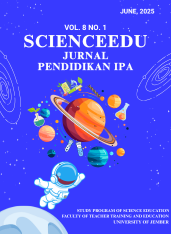Ethnomathematical Exploration of Numeration Systems: The Mee Tribal Indigenous Community
DOI:
https://doi.org/10.19184/se.v8i1.53688Keywords:
Ethnomathematics, Numeracy System, Mee Tribe, Indigenous Peoples, Cultural ExplorationAbstract
This study aims at documenting and analyzing the traditional number system of the Mee tribe in Papua within an ethnomathematics framework. Papua is a cultural well with the numeral system reflecting the values of the culture and the social structure of the society. Such integration of culturally based mathematical concepts with the help of the ethnometematic approach might be theoretically expected to enhance mathematical learning, relevant from a cultural point of view. Qualitative research with participatory observation, in-depth interviews, and artifact analysis was carried out in Sentani-Sereh. From the research, it can be said that the uniqueness of the combination between single and decimal numbers can indicate the structure of the Mee Tribe culture. This system shows a possibility for implementation in culture-based learning. This documentation leans more towards cultural preservation efforts, enriching the literature of ethno-mathematics and recognizing traditional knowledge, which is part of cultural heritage and needs to be preserved in the wave of modernization
Downloads
References
Abdulrahim, N.A., & Orosco, M.J. (2020). Culturally responsive mathematics teaching: A research synthesis. The urban review, 52(1), 1-25.https://doi.org/10.1007/s11256-019-00509-2
Abi, AM (2017). Integration of Ethnomathematics in School Mathematics Curriculum. JPMI (Jurnal Pendidikan Matematika Indonesia), 1(1), 1. https://doi.org/10.26737/jpmi.v1i1.75
Alexon, NS, & Sukmadinata, NS (2010). Development of Integrated Learning Model Based on Culture to Increase Students' Appreciation of Local Culture. Jurnal Cakrawala Pendidikan, 19(2), 189-203. https://doi.org/10.21831/cp.v2i2.339.
Anwas, Oos M. 2006. “Evaluative Study of the Utilization of School Educational Videos in Learning”, Jurnal Teknodik, Vol. 10, No. 18. pp. 59-74.
Ascher, C. (1991). School Programs for African American Male Students. Trends and Issues No. 15.
Bishop, A. J. (1988). Mathematics education in its cultural context. Educational studies in mathematics, 19(2), 179-191.
Branch, Robert Maribe. 2009. Instructional Design: The ADDIE Approach. New York: Springer Publications.
Burton, JK and Merrill, PF 1977. "Need assessment: Goals needs, and priorities", In Leslie J. Briggs (ed), Instructional design: Principles and applications, 24-46, New Jersey: Educational Technology.
d'Ambrosio, U. (1985). Ethnomathematics and its place in the history and pedagogy of mathematics. For the learning of Mathematics, 5(1), 44-48.
D'Ambrosio, U. (1990). The role of mathematics education in building a democratic and just society. For the learning of mathematics, 10(3), 20-23.
Dwiningsih, K. and Rahma, PT, 2018. Development of Chemistry Learning Media Using Virtual Laboratory Media Based on Learning Paradigms in the Global Era. Kwangsan: Journal of Educational Technology, 6(2), 156. DOI:http://dx.doi.org/10.31800/jtp.kw.v6n2.p156--176
Directorate General of Primary and Secondary Education, Ministry of Education and Culture, 2017, Core competencies and basic competencies of national content subjects, regional content, basic expertise programs, and expertise competencies, Jakarta: Ministry of Education and Culture. Downloaded June 20, 2018,http://psmk.kemdikbud.go.id/kikd2017.
Fullan, M. 1996a, The new meaning of educational change, Cassell, London.
Gay, G. (2018). Culturally responsive teaching: Theory, research, and practice. teachers college press.
Green, B. W., & Zaslavsky, C. (1975). African Counts: Numbers and Patterns in African Culture. ASA Review of Books, 1, 1. https://doi.org/10.2307/532492
Hendrawati, NE, Muttaqin, N., & Susanti, E. (2019). Ethnomathematics: numeracy literacy based on language in the Kowai tribe, Kaimana Regency. In Proceedings of SIMaNIs (National Seminar on the Integration of Mathematics and Islamic Values (Vol. 3, No. 1, pp. 239-243). Mathematics Study Program, UIN Maulana Malik Ibrahim Malang.
Hidayat, Feriawan. 2016. Regarding English Language Ability, Indonesia is Considered Still Behind. Downloaded March 2, 2018, http://www.beritasatu.com/education/403858.
Ifrah, G. (2000). The universal history of numbers. London: Harville.
Karnilah, N. (2013). Study ethnomathematics: Disclosure of the Baduy indigenous community's number system (Doctoral dissertation, Indonesian University of Education).
Kusuma, DA, Ruchjana, BN, Widodo, SA, & Dwipriyoko, E. (2024). Combination Of Ethnomathematics And The Mozart Effect To Improve Problem-Solving Skills And Mathematical Disposition. Barekeng: Journal Of Mathematics And Applied Sciences, 18(2), 1155-1166. https://doi.org/10.30598/barekengvol18iss2pp1155-1166
Ladson-Billings, G. (1995). Toward a theory of culturally relevant pedagogy. American educational research journal, 32(3), 465-491.https://doi.org/10.2307/1163320
McGee Banks, C. A., & Banks, J. A. (1995). Equity pedagogy: An essential component of multicultural education. Theory into practice, 34(3), 152-158. https://doi.org/10.1080/00405849509543674
Nasir, NIS, Hand, V., & Taylor, E. V. (2008). Culture and mathematics in school: Boundaries between “cultural” and “domain” knowledge in the mathematics classroom and beyond. Review of research in education, 32(1), 187-240.https://doi.org/10.3102/0091732x07308962
Palmer, GR & Short, SD 2010, Health care and public policy: an Australian analysis, 4th edn, Palgrave Macmillan, South Yarra, Vic.
Patton, M. Q. (2002). Two decades of developments in qualitative inquiry: A personal, experiential perspective. Qualitative social work, 1(3), 261-283.https://doi.org/10.1177/1473325002001003636
Purnomo, Edi. 2007. Development of learning video media for deaf elementary school students, Master of Education Thesis, Surabaya: Universitas PGRI Adibuana.
Rosa, M., & Orey, D. C. (2011). Ethnomathematics: the cultural aspects of mathematics. Revista Latinoamericana de Etnomatemática Perspectivas Socioculturales de La Educación Matemática, 4(2), 32-54.https://doi.org/10.5007/1981-1322.2020.e67502
Rosida, V., Taqwa, M., & Kamaruddin, R. (2018). The effectiveness of ethnomatics approach based on local culture in mathematics learning. Histogram: Journal of Mathematics Education, 2(2), 97-107.https://doi.org/10.31100/histogram.v2i2.235
Sanusy, Rukan. 2014. The Relationship between Students' Interest in Watching English Language Films and Students' Learning Achievement in Speaking Class 2 of SMPN 1 Gandusari Trenggalek. Thesis, IAIN Tulungagung. Downloaded April 19, 2018,http://repo.iain-tulungagung.ac.id/478.Sharma, T., & Orey, D.C. (2017). Meaningful mathematics through the use of cultural artifacts. Ethnomathematics and its diverse approaches for mathematics education, 153-179.https://doi.org/10.1007/978-3-319-59220-6_7
Spradley, B. W. (1980). Managing change creatively. JONA: The Journal of Nursing Administration, 10(5), 32-36.https://doi.org/10.1097/00005110-198005000-00007
Ulum, Omer Gokhan. 2015. "A Needs Analysis Study for Preparatory Class ELT Students". European Journal of English Language Teaching, Vol. 1, issue 1, pp. 14-29
Zhang, Q., & Seah, W.T. (2021). Thematic issue on values and valuing in mathematics education: Revisiting mathematics education from cultural perspectives. ECNU Review of Education, 4(2), 225-229.https://doi.org/10.1177/20965311211011628
Zairi, M. (ed) 1999, Best practice: process innovation management, Butterworth-Heinemann, Oxford.
Downloads
Published
How to Cite
Issue
Section
License
Copyright (c) 2025 ScienceEdu

This work is licensed under a Creative Commons Attribution-NonCommercial-ShareAlike 4.0 International License.


